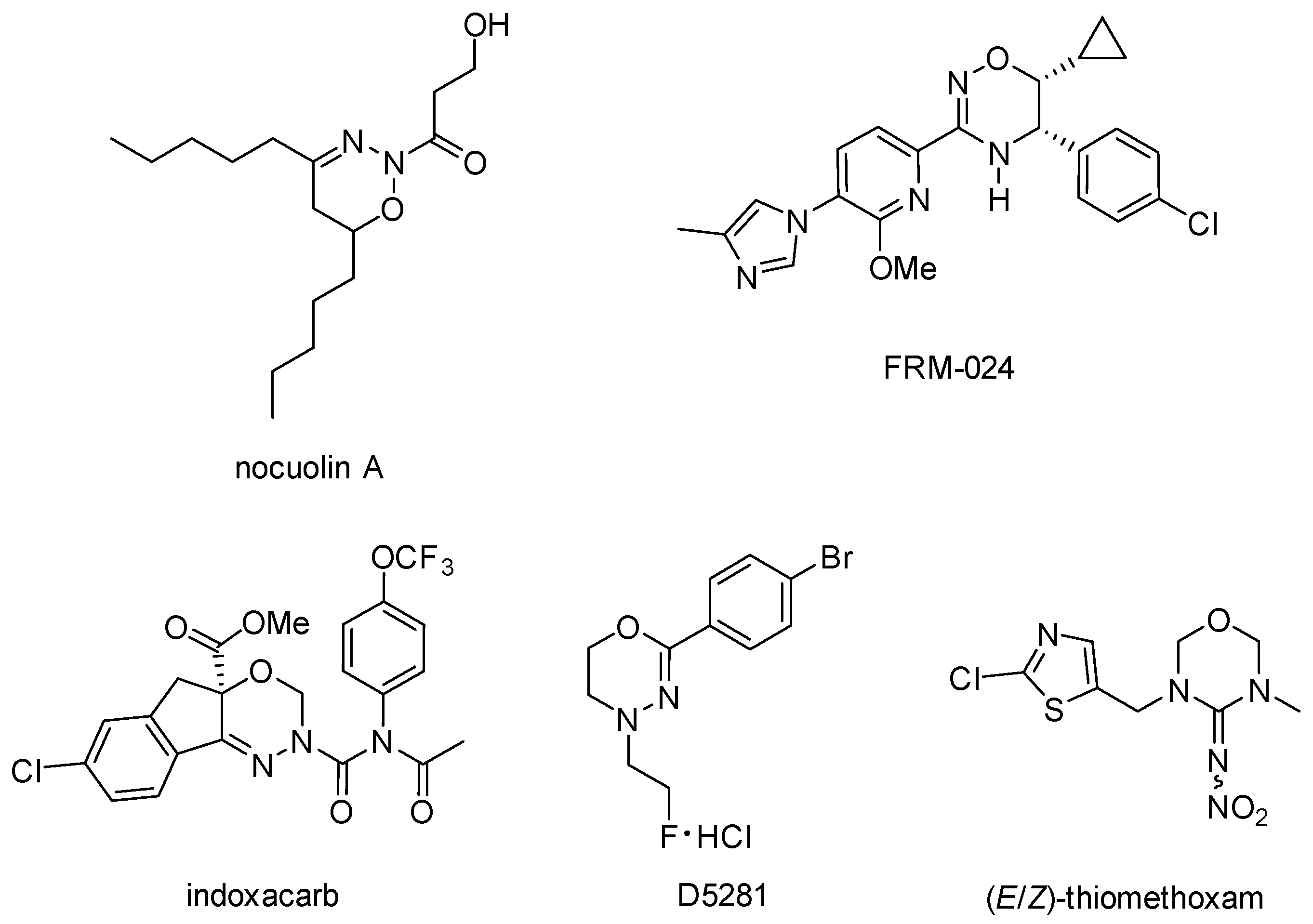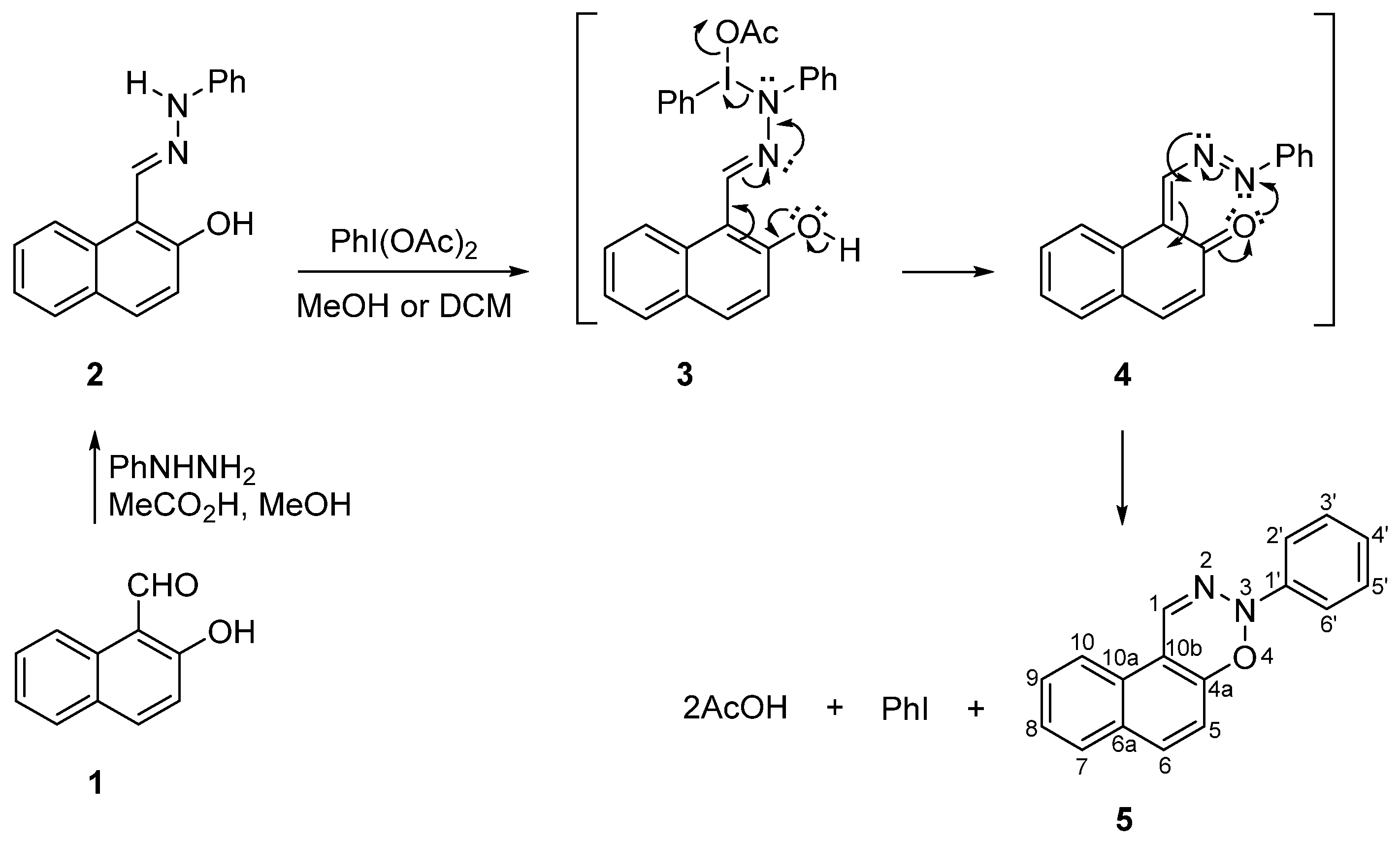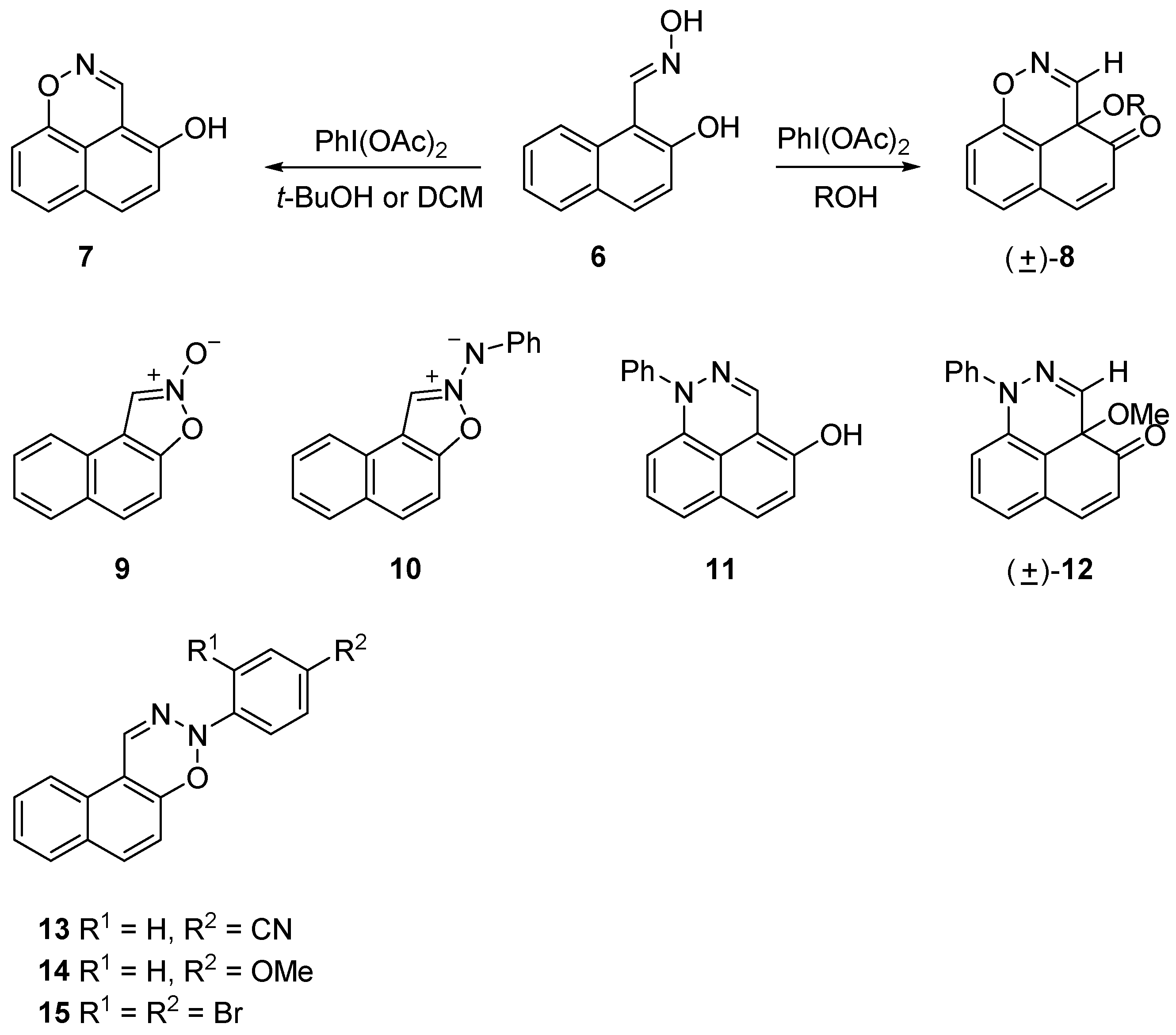3-Phenyl-3H-naphtho[1,2-e][1,2,3]oxadiazine
Abstract
:1. Introduction
2. Results
3. Discussion
4. Materials and Methods
4.1. (E)-1-[(2-Phenylhydrazono)methyl]naphthalen-2-ol (2)
4.2. 3-Phenyl-3H-naphtho[1,2-e][1,2,3]oxadiazine (5)
Supplementary Materials
Author Contributions
Funding
Data Availability Statement
Acknowledgments
Conflicts of Interest
Sample Availability
References
- Voráčová, K.; Hájek, J.; Mareš, J.; Urajová, P.; Kuzma, M.; Cheel, J.; Villunger, A.; Kapuscik, A.; Bally, M.; Novák, P.; et al. The cyanobacterial metabolite nocuolin A is a natural oxadiazine that triggers apoptosis in human cancer cells. PLoS ONE 2017, 12, e0172850. [Google Scholar] [CrossRef] [PubMed] [Green Version]
- Bursavich, M.G.; Harrison, B.A.; Acharya, R.; Costa, D.E.; Freeman, E.A.; Hrdlicka, L.A.; Jin, H.; Kapadnis, S.; Moffit, J.S.; Murphy, D.; et al. Discovery of the Oxadiazine FRM-024: A Potent CNS-Penetrant Gamma Secretase Modulator. J. Med. Chem. 2021, 64, 14426–14447. [Google Scholar] [CrossRef] [PubMed]
- Eissa, F.M. Green Synthesis, Antibacterial, and Antifungal Activities of 1,3,4-Oxadiazines. J. Heterocycl. Chem. 2018, 55, 1479–1483. [Google Scholar] [CrossRef]
- Shindy, H.A.; Goma, M.M.; Harb, N.A.E.R. Synthesis, spectral behavior and biological activity of some novel 1,3,4-oxadiazine cyanine dyes. Eur. J. Chem. 2015, 6, 151–156. [Google Scholar] [CrossRef] [Green Version]
- Mohareb, Ρ.Μ.; Schatz, J. Anti-tumor and anti-leishmanial evaluations of 1,3,4-oxadiazine, pyran derivatives derived from cross-coupling reactions of β-bromo-6H-1,3,4-oxadiazine derivatives. Bioorg. Med. Chem. 2011, 19, 2707–2713. [Google Scholar] [CrossRef] [PubMed]
- Mohareb, R.M.; Ibrahim, R.A.; Moustafa, H.E. Hydrazide-Hydrazones in the Synthesis of 1,3,4-Oxadiazine, 1,2,4-Triazine and Pyrazole Derivatives with Antitumor Activities. Open Org. Chem. J. 2010, 4, 8–14. [Google Scholar] [CrossRef]
- Xu, D.; Guan, J.; Xu, X.; Gong, S.; Xu, H. A New Method for the Synthesis of Oxadiazine Insecticide Indoxacarb. J. Heterocycl. Chem. 2016, 53, 1469–1473. [Google Scholar] [CrossRef]
- Dekeyser, M.A.; Mitchell, D.S.; Downer, R.G.H. Improved Synthesis and Spectral Characterization of D5281, an Oxadiazine Miticide/Insecticide. J. Agric. Food Chem. 1994, 42, 1783–1785. [Google Scholar] [CrossRef]
- Shobana, N.; Farid, P. Six-membered Rings with Three or more Heteroatoms, and their Fused Carbocyclic Derivatives. In Comprehensive Heterocyclic Chemistry III; Katritzky, A.R., Ramsden, C.A., Scriven, E.F.V., Taylor, R.J.K., Eds.; Elsevier Science: Oxford, UK, 2008; Volume 9, pp. 457–521. [Google Scholar] [CrossRef]
- Gharpure, S.J. Six-membered Rings with Three or more Heteroatoms, and their Fused Carbocyclic Derivatives. In Comprehensive Heterocyclic Chemistry IV; Black, D.S., Cossy, J., Stevens, C.V., Eds.; Elsevier Science: Oxford, UK, 2022; Volume 9, pp. 284–506. [Google Scholar] [CrossRef]
- Alqaraghuli, H.G.J.; Kadhim, Z.Y.; Ameena, N.; Seewan, A.N. Synthesis, Characterization, Theoretical Study, Antioxidant Activity and in Vitro Cytotoxicity Study of Novel Formazan Derivatives Toward MCF-7 Cells. Egypt. J. Chem. 2022, 65, 181–188. [Google Scholar] [CrossRef]
- Ghosh, K.; Kumar, R.; Kumar, S.; Bala, M.; Singh, U.P. Orthometallation in bidentate Schiff base ligands via C–H activation: Synthesis of ruthenium(III) organometallic complexes. Transit. Met. Chem. 2015, 40, 831–837. [Google Scholar] [CrossRef]
- Dolka, C.; Hecke, K.V.; Meervelt, L.C.; Tsoungas, P.G.; Eycken, E.V.D.; Varvounis, G. Novel Thermal and Microwave-Assisted Facile Route to Naphthalen-2(1H)-ones via an Oxidative Alkoxylation-Ring-Opening Protocol. Org. Lett. 2009, 11, 2964–2967. [Google Scholar] [CrossRef] [PubMed]
- Liaskopoulos, T. Oxidation Reactions of Hydrazone and Oxime Derivatives of 2-hydroxy-1-naphthaldehyde. Master’s Thesis, University of Ioannina, Ioannina, Greece, 2005. [Google Scholar]
- Supsana, P.; Tsoungas, P.G.; Varvounis, G. A Novel One-pot Synthesis of Isomeric Naphtho[1,2-d]isoxazole-2-oxide and Naphtho[1,8-de][1,2]oxazine Ring Systems. A Case of Simultaneous O- and Peri- Cyclisation in Naphthalene. Tetrahedron Lett. 2000, 41, 1845–1847. [Google Scholar] [CrossRef]
- Supsana, P.; Tsoungas, P.G.; Aubry, A.; Skoulika, S.; Varvounis, G. Oxidation of 1-Acyl-2-naphthol oximes: Peri- and/or o-Cyclisation and/or Spiro Cyclodimerisation of o-Nitrosoquinone methide Intermediates. Tetrahedron 2001, 57, 3445–3453. [Google Scholar] [CrossRef]



Publisher’s Note: MDPI stays neutral with regard to jurisdictional claims in published maps and institutional affiliations. |
© 2022 by the authors. Licensee MDPI, Basel, Switzerland. This article is an open access article distributed under the terms and conditions of the Creative Commons Attribution (CC BY) license (https://creativecommons.org/licenses/by/4.0/).
Share and Cite
Aouant, A.D.; Varvounis, G. 3-Phenyl-3H-naphtho[1,2-e][1,2,3]oxadiazine. Molbank 2022, 2022, M1432. https://doi.org/10.3390/M1432
Aouant AD, Varvounis G. 3-Phenyl-3H-naphtho[1,2-e][1,2,3]oxadiazine. Molbank. 2022; 2022(3):M1432. https://doi.org/10.3390/M1432
Chicago/Turabian StyleAouant, Alia D., and George Varvounis. 2022. "3-Phenyl-3H-naphtho[1,2-e][1,2,3]oxadiazine" Molbank 2022, no. 3: M1432. https://doi.org/10.3390/M1432
APA StyleAouant, A. D., & Varvounis, G. (2022). 3-Phenyl-3H-naphtho[1,2-e][1,2,3]oxadiazine. Molbank, 2022(3), M1432. https://doi.org/10.3390/M1432






